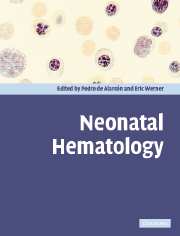Book contents
- Frontmatter
- Contents
- List of contributors
- Foreword
- Preface
- 1 Neonatal hematology: a historical overview
- 2 Disorders of the fetomaternal unit
- 3 Erythropoiesis, red cells, and the approach to anemia
- 4 Anemia of prematurity and indications for erythropoietin therapy
- 5 Hypoplastic anemia
- 6 Hemolytic disease of the fetus and newborn
- 7 Neonatal hemolysis
- 8 Neonatal screening for hemoglobinopathies
- 9 Polycythemia and hyperviscosity in the newborn
- 10 Newborn platelet disorders
- 11 Neutrophil function and disorders of neutrophils in the newborn
- 12 Immunodeficiency diseases of the neonate
- 13 Hemostatic abnormalities
- 14 Transfusion practices
- 15 Umbilical-cord stem-cell transplantation
- 16 Neonatal oncology
- 17 Normal values and laboratory methods
- Index
- References
14 - Transfusion practices
Published online by Cambridge University Press: 10 August 2009
- Frontmatter
- Contents
- List of contributors
- Foreword
- Preface
- 1 Neonatal hematology: a historical overview
- 2 Disorders of the fetomaternal unit
- 3 Erythropoiesis, red cells, and the approach to anemia
- 4 Anemia of prematurity and indications for erythropoietin therapy
- 5 Hypoplastic anemia
- 6 Hemolytic disease of the fetus and newborn
- 7 Neonatal hemolysis
- 8 Neonatal screening for hemoglobinopathies
- 9 Polycythemia and hyperviscosity in the newborn
- 10 Newborn platelet disorders
- 11 Neutrophil function and disorders of neutrophils in the newborn
- 12 Immunodeficiency diseases of the neonate
- 13 Hemostatic abnormalities
- 14 Transfusion practices
- 15 Umbilical-cord stem-cell transplantation
- 16 Neonatal oncology
- 17 Normal values and laboratory methods
- Index
- References
Summary
Transfusion therapy in the neonatal population requires an understanding of the dynamic interactions of the fetomaternal unit, the physiologic changes that accompany the transition from fetus to neonate and from neonate to infant, and the underlying pathophysiology of different hematologic disorders. Blood products utilized in neonates include packed red blood cells (PRBC), platelet concentrates, granulocyte concentrates, fresh frozen plasma (FFP), and cryoprecipitate, but modifications of the components are often required to compensate for the small blood volume, immunologic immaturity, and compromised organ function of the transfusion recipients, who may be premature and/or sick. Extremely low-birth-weight infants (birth weight <1000 g) invariably receive one or more RBC transfusions, especially in the first few weeks of life [1]. Intensive blood-bank support with PRBCs, platelets, and FFP is vital for neonates undergoing extracorporeal membrane oxygenation (ECMO) or cardiopulmonary bypass [2, 3].
Although the transfusion of blood products has been an integral part of supportive care of critically ill neonates for decades, guidelines for transfusions remain controversial, since most have been extrapolated from evidence in adults or based on small studies in neonates with marginal statistical validity. The growing awareness of the hazards of blood transfusion, both among medical professionals and in the lay public, has led to a re-evaluation of this hitherto commonly accepted practice, with the development of strategies to minimize risk and improve benefits.
- Type
- Chapter
- Information
- Neonatal Hematology , pp. 349 - 375Publisher: Cambridge University PressPrint publication year: 2005



